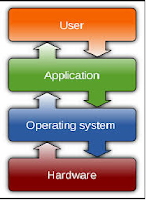An operating system acts as an intermediary between the user of
a computer and computer hardware. An operating system is software that manages
the computer hardware.
The hardware must provide appropriate mechanisms to ensure the
correct operation of the computer system and to prevent user programs from
interfering with the proper operation of the system. It’s means operating system (OS) is system software that manages computer
hardware and software resources and provides common services for computer
programs.
Functions of an operating system :
The operating systems perform the following functions :
1. Booting
2. Formatting
3. Managing computer resources
4. Managing files
5. Managing tasks
Booting : Uses
diagnostic routines to test system for equipment failure. Copies BIOS ( Basic
Input System) programs from ROM chips to main memory. Loads
operating system into computers main memory.
Formatting : Formats
diskettes so they can store data and programs.
Managing computer resources :
Keeps track of locations in main memory where programs and data
are stored ( memory management). Move data and programs back and forth between
main memory and secondary storage via partitioning, using
foreground and background areas, and using buffer and queues.
Managing files :
· Copies files and copy programs from one disk
to another.
· Backup files and programs.
· Erases files and programs.
· Renames files.
Managing tasks :
May be able to perform multi-tasking, multi-
programming, time-sharing or multi-processing.
The various types of operating system are as follows :
Batch Operating
System :
This type of operating system was used in the earlier age. This type of operating system do not interact with the computer directly. There is an operator which takes similar jobs having same requirement and group them into batches. The definitive feature of a batch system is the lack of interaction between the user and the job while that job is executing.
This type of operating system was used in the earlier age. This type of operating system do not interact with the computer directly. There is an operator which takes similar jobs having same requirement and group them into batches. The definitive feature of a batch system is the lack of interaction between the user and the job while that job is executing.
Multi-programming
system :
In this type of operating system, more than one
program will reside into main memory. The operating system picks and begins to
execute one of the jobs in the memory. Eventually, the job may have to wait for
some task, the operating system simply switches to another job and executes it.
When the first job finishes, waiting job gets the CPU back.
Time-Sharing Operating
Systems :
Each task has given some time to execute, so that all the tasks work smoothly. Each user gets time of CPU as they use single system. These systems are also known as Multitasking Systems. The task can be from single user or from different users also.
Each task has given some time to execute, so that all the tasks work smoothly. Each user gets time of CPU as they use single system. These systems are also known as Multitasking Systems. The task can be from single user or from different users also.
A time-shared
operating system uses CPU scheduling and multi-programming to provide each user
with a small portion of a time-shared computer.
Real-Time Operating System :
These types of Operating systems serves the real-time
systems. The time interval required to process and respond to inputs is very
small.
Real time operating system is a special purpose
operating system.used when there are rigid time requirements on the operation
of a processor or the flow of data.
Real-time systems are used when there are time requirements are very
strict like, air traffic control systems, robots etc.
Two types of Real-Time Operating System which are as follows:
· Hard Real-Time Systems
· Soft Real-Time Systems
· Hard Real-Time Systems:
These Operating Systems are meant for the
applications where time constraints are very strict and even the shortest
possible delay is not acceptable. It is short-term of data integrity and size
of data files small/medium.
· Soft Real-Time Systems:
These Operating Systems are for applications
where for time-constraint is less strict. It is long-term of data integrity and
size of data files large.
Functions of an operating system & types
 Reviewed by Shubham Rathor
on
February 10, 2019
Rating:
Reviewed by Shubham Rathor
on
February 10, 2019
Rating:
 Reviewed by Shubham Rathor
on
February 10, 2019
Rating:
Reviewed by Shubham Rathor
on
February 10, 2019
Rating:








No comments: